Research of hydraulic gradient for large particle slurry in inclined pipeline
Jian-hua LIU,Yi-fan LIU,Miao-xin XIAO
(1 Xinxiang University,Xinxiang 453003,China)
(2 Northeast Forestry University,Harbin 150040,China)
Abstract:The experimental data of large particle slurry pipeline transportation at home and abroad and the test data in production practice was analyzed and studied by literature research method and theoretical analysis method.The equation was given by the nonlinear fitting method for calculating the interference force correction coefficient of large size solid particles,and a new computational model was proposed for hydraulic gradient of large particle slurry based on the momentum transfer relationship between solid particles and water.It was verified by relevant test data for the computational model,and the result showed that the computational model was correct.The research results can provide theoretical basis for the study on the resistance loss of large particle slurry.
Key words:Large particles,Force model,Slurry,Hydraulic gradient
1 Introduction
In recent years,slurry pipeline transportation was rapid development for solid particle transportation,more and more slurry pipeline project involves the technology of transporting large particle materials.In slurry pipeline transportation,transportation cost caused by resistance loss is one of the main costs of slurry transportation.While for the pipeline transportation engineering design,the slurry pipeline resistance loss is related to the selection of slurry pump,reasonable pipeline structure and various transportation parameters.Therefore,the research of hydraulic gradient has become one of the main research content for pipeline transportation technology.Due to the many factors influencing the hydraulic gradient of slurry transportation in pipelines,the current research in this field is not perfect and needs to be further studied,although many experts and scholars have studied the hydraulic gradient of large particles[1-6].
Based on the two-phase flow theory,the average velocity,pipe dip angle and hydraulic slope of settling slurry in inclined pipe are measured by the test method,the resistance loss model in inclined pipe is established,and the resistance loss of large granular slurry in inclined pipe is analyzed.Only the research results of resistance loss in inclined pipe are given in the paper.
2 Establishment of force model for large particles
2.1 Establishment of force model for large particles
In a minute amount of timeΔt,the mass of a solid particle discharged from pipes with sectional area of d A is Ms,and the mass of the fluid discharged from pipes with sectional area of d A is Mw.The momentum balance equation and the continuity equation of thesolid particles and the fluid can be expressed as follows[7]:

Where:v is velocity of clear water before momentum exchange,q is the volume concentration of a solid particle,vwis water velocity,vsis solid velocity,vmis slurry speed.
The coefficient k1and k2can be calculated by the following two equation s[8].

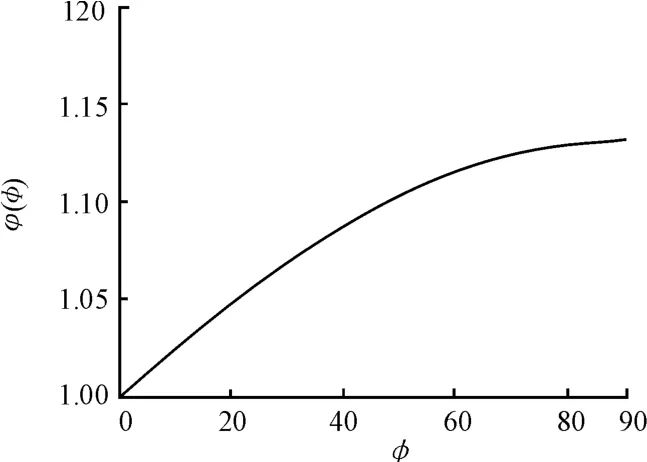
Fig.1 Realtion betweenφ(φ)andφ

At the end of the particle acceleration process,d vs/d t=0,the equation of motion of particles can be expressed as follows:

Where fDis fluid drag force on particles,CDris the drag coefficient,fhis interference forces from other particles,ffis the force of friction acting on a single solid particle.They can be calculated separately by the following equation.
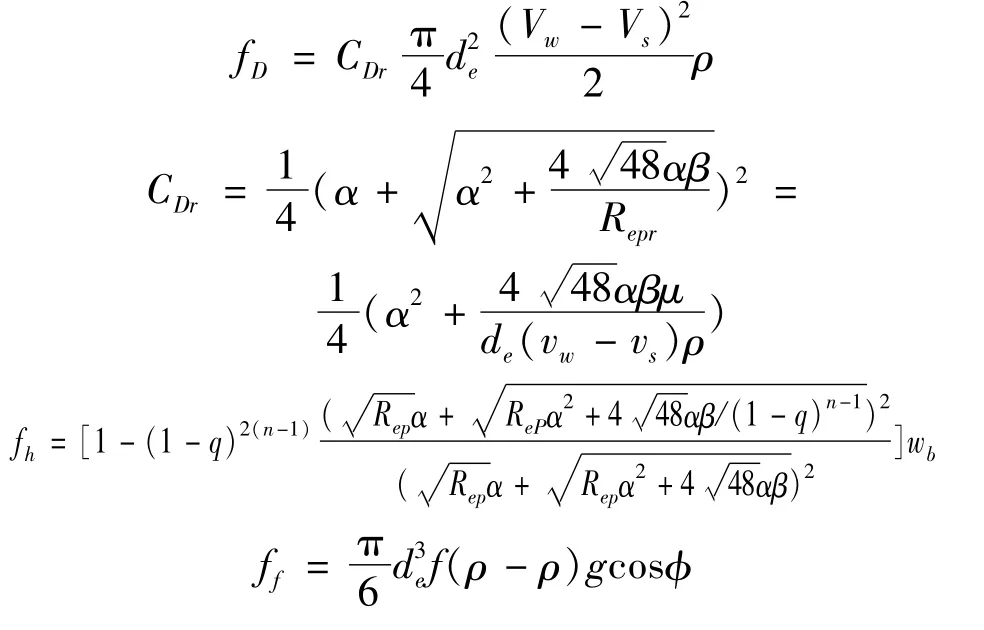
Where Repis reynolds number of particles.αandβ are particle Swanson constant respectively.n is index,and the calculation method referred to literature[10-13].deis the equivalent diameter of a spherical solid particle.wbis the effective gravity of a solid particle,.
Because interference forces exist in turbulent states,vortices flow appeared behind the large particles according to the test results of Xia-jianxin.This causes the particles to be subjected to additional resistance.For the flow of large particles in pipeline for any Angle,additional forces are taken into account,and the interference force need to be corrected by the interference force correction coefficient K to study the resistance of large particles in motion.Therefore,considering the situation of large particles,the motion equation of particles can be expressed as follows[14].

Then,the calculation model of the correction coefficient K is as follows:

When unit length pipeline is took as the research object,flow parameters in the pipeline is as follows:the average concentration in the pipe is¯q,the average velocity of the slurry is Vm,the average velocity of solid particles is Vs,and the average velocity of the liquid is Vw.Then the calculated equation of fhbecomes as follows,which stands for the interference force of other particles.

2.2 Determining correction coefficient of interference force
In order to determine the specific expression of the coefficient K,under different conditions some calculations were done for the correction coefficient of the interference force by using the actual measured data from other experts such as Newitt et al.[15-18]and equation(8).Based on the calculation results,the relation between K and(1-C)Vmd/VtD are fitted nonlinearly.The fitted curve obtained is expressed by equation(10),and the fitting results are shown in Fig.2.

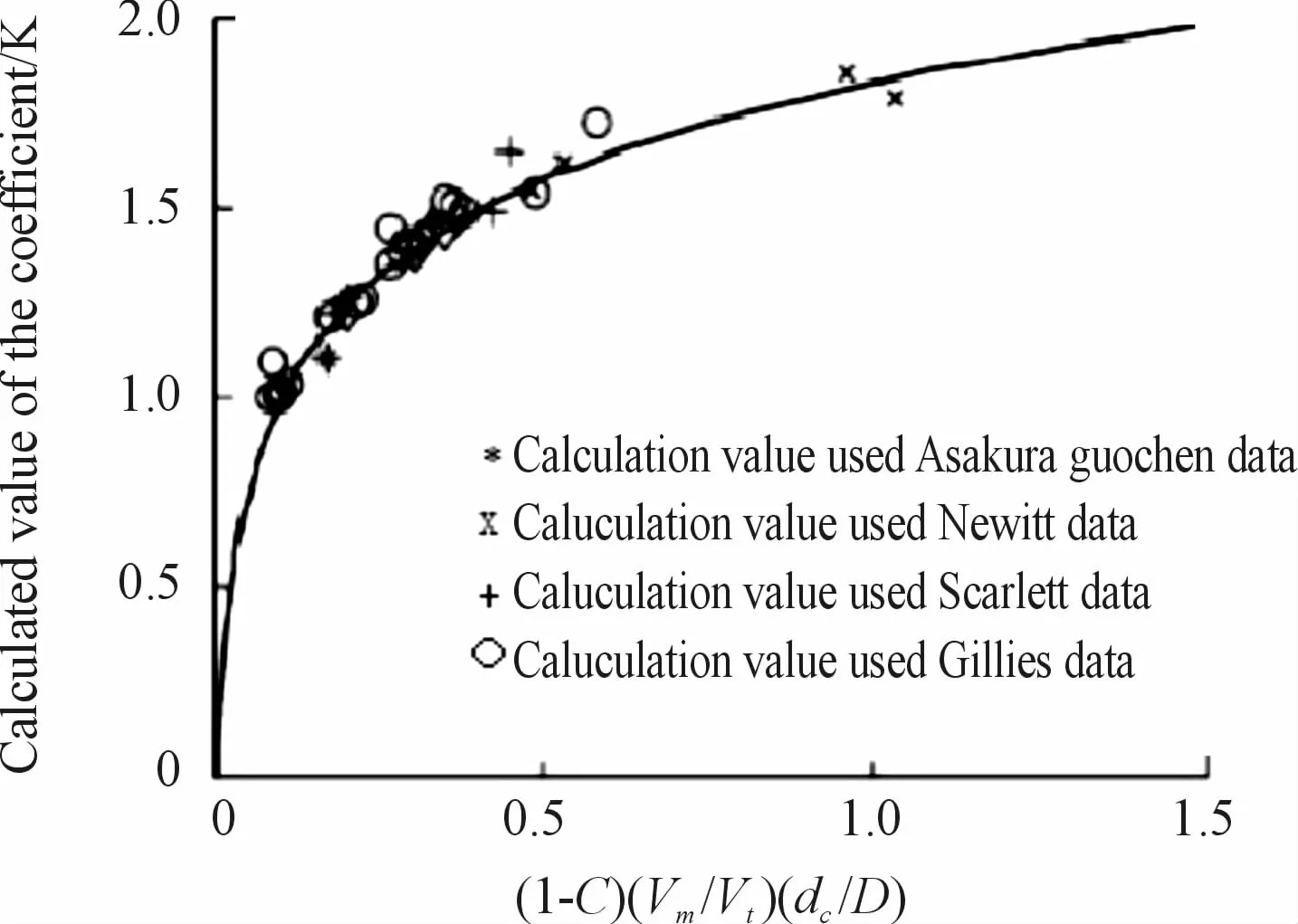
Fig.2 Relation between Coefficient K and(1-C)(Vm/Vt)(d/D)
3 Hydraulic slope calculation model for large granular slurry
3.1 Research status of hydraulic slope calculation model for large granular slurry
The calculation of hydraulic slope of slurry pipeline is an important content in slurry pipeline design.In recent years,many experts and scholars studied the hydraulic gradient of large granular slurry with the emergence of large particle slurry pipeline projects,and many calculation models and equation s were put forward,such as those of Durand,Wasp,Wilson and others.
An emperor is a (male) monarch13, usually the sovereign ruler of an empire or another type of imperial realm. Empress is the feminine form. As a title, empress may indicate the wife of an emperor (empress consort) or a woman who is a ruling monarch (empress regnant). Emperors are generally recognised to be above kings in honour and rank.Both kings and emperors are monarchs14. There is no single rule to distinguish the one from the other: several factors, like interpretations15 of historians, the size and characteristics of the governed realm, and the title(s) chosen by the monarch play a part in distinguishing the one from the other. General characteristics indicating that a monarch is to be considered an emperor rather than a king include:
According to a large number of experimental data,Durand proposed Durand model based on the gravity theory.The starting point of gravity theory is to transport all particles in suspension.Therefore,the application of this theory will inevitably lead to a larger calculation result.Wasp divides slurry into carrier part and conveying part based on Durand theory.Wasp computing model was presented,which is widely used at home and abroad.The resistance separately was calculated and stacked in the calculation model.However,the calculation result is relatively large,because it is based on Durand theory.Wilson proposed a twolayer model to calculate the hydraulic gradient in the presence of a sliding bed.In this model,the complex problems of liquid and solid phase flow were reduced to simple geometric problems.
Above expert’s research on the hydraulic gradient basically based on the energy Angle.However,the energy loss in the momentum exchange between fluid and solid particles is not converted into kinetic energy or energy,but into other forms of energy such as heat energy.Therefore,the study and analysis of hydraulic slope of slurry pipeline should be carried out from the perspective of momentum.
3.2 Derivation of hydraulic slope calculation model for large particle slurry
When the flow in the pipeline is in turbulent,the hydraulic gradient can be expressed by the following equation.

Whereλis Darcy resistance coefficient.V is the velocity before momentum exchange between clear water and coarse sand particles.
If the flow parameters in the pipe are as follows,the average concentration in the pipe is¯q,the average velocity of solid particles is Vs,and the average velocity of the liquid is Vw.Then the expression of the average velocity of the fluid before momentum exchange V is as follows:

For settling slurry,the settling slurry flowing at an average velocity Vmcan be regarded as clear water flowing at an average velocity V according to equation(12).That is to say,the hydraulic gradient generated when the sedimentary slurry flows in the pipeline at a speed of V can be considered as the hydraulic gradient of water flowing in the pipeline at a speed of Vm.Its principle is shown as in Fig.3.Therefore,if V is calculated using the given delivery conditions,the resist-ance loss of large particle slurry under flow conditions can be calculated according to the flow velocity V.Process of flow in the tube The i-V curve of water and two-phase flow
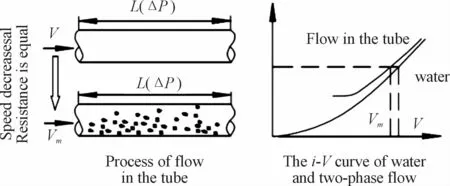
Fig.3 Principles of equivalent resistance model
Therefore,the hydraulic gradient of large-particle slurry can be solved by combining equation(12)and equation(11),the result can be described as:
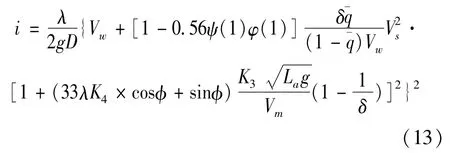
The hydraulic gradient of slurry involves Vwand Vscan be calculated by equation(13).The hydraulic gradient of large-particle slurry can be calculated by equation(13).The velocity of water is obtained before liquid and solid momentum exchange in the pipe.Then hydraulic gradient of large-particle slurry can be calculated by equation(11).
4 Calculation and calculation results analysis of hydraulic gradient for large particle slurry
4.1 Calculation of hydraulic gradient for largeparticles
The hydraulic gradient of large-particle slurry is affected by the relevant parameters of the slurry(included average slurry velocity,slurry transport concentration,average in-pipe concentration),related parameters of particles(included equivalent diameter of particle sphere,particle density,particle area index),parameters related to fluid transport(included fluid density,fluid viscosity),relevant parameters of pipeline(included pipe diameter,pipe inclination,pipe roughness),etc.The calculation steps of hydraulic gradient for large-particle slurry are shown in Fig.4.
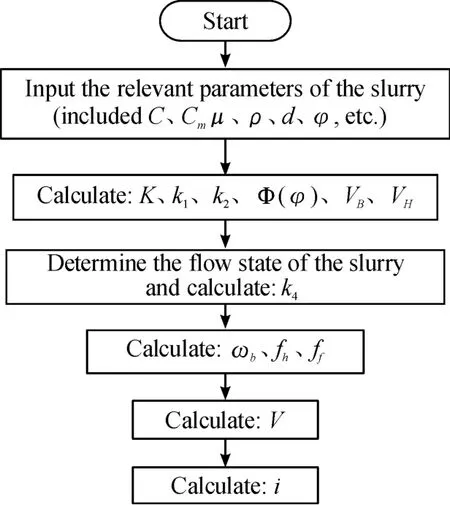
Fig.4 Calculation procedure diagram of hydraulic gradient of large-particle slurry
4.2 Validation of the hydraulic gradient model for large particle slurry
Experimental data of Kao and Coiado et al[19-22]were used to verify the hydraulic gradient model of inclined pipeline.Specific test parameters and flow conditions are shown in Table 1.When the particles are in various flow states,the comparison between the calculated and experimental values of hydraulic gradient are shown in Figs.5-6.

Fig.5 Comparison of measured and computed values of hydraulic gradien
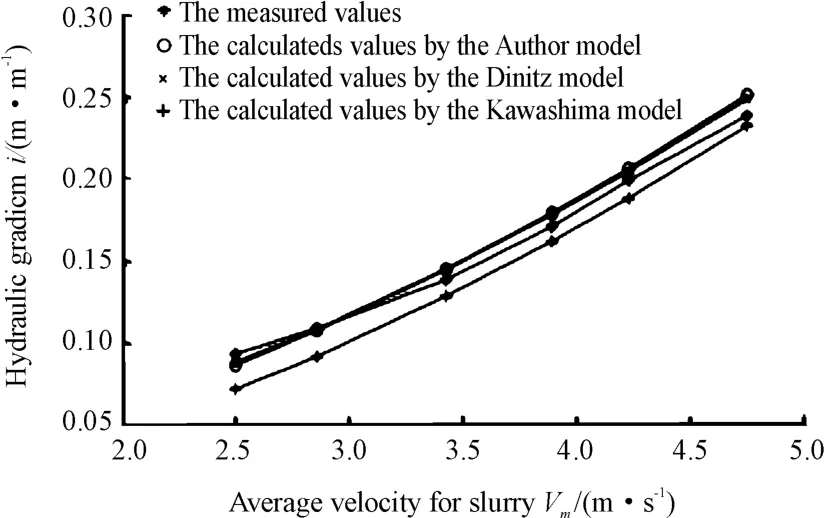
Fig.6 Comparison between author’s hydraulic gradient calculation model and other models

Table 1 Test parameters in non-horizontal pipe for verifying model of hydraulic gradient
The comparison between the calculation results of hydraulic Gradient by myself model,Worcester model and Kawashima model[23-27]according to Huang zhao-lin’s test data of inclined pipeline were shown as Fig.5.In the experiment,the density of solid particle was 1.552 g/cm3,and the average volume concentration was 21.74%.
The comparison between the experimental value of Coiado and the calculated value of the model proposed in this paper were shown as Fig.6.In this experiment,the density of solid particle was 2.68 g/cm3,and the average volume concentration was 5%.As shown in Fig.6,the calculated value of Kawashima equation is generally smaller than the measured value,while the calculated value of Dinitz is larger than the measured value.
4.3 Comparative analysis of hydraulic slope model of large grainy slurry
According to Fig.5,the error of the author’s model is smaller than that of the other two models.At low speed,there is some error.
The error between the author’s model and the measured value is less than 10%.According to Fig.6 and Fig.7,the deviation between the calculated value and the measured value is very small at high velocity for the calculation model proposed in this paper.
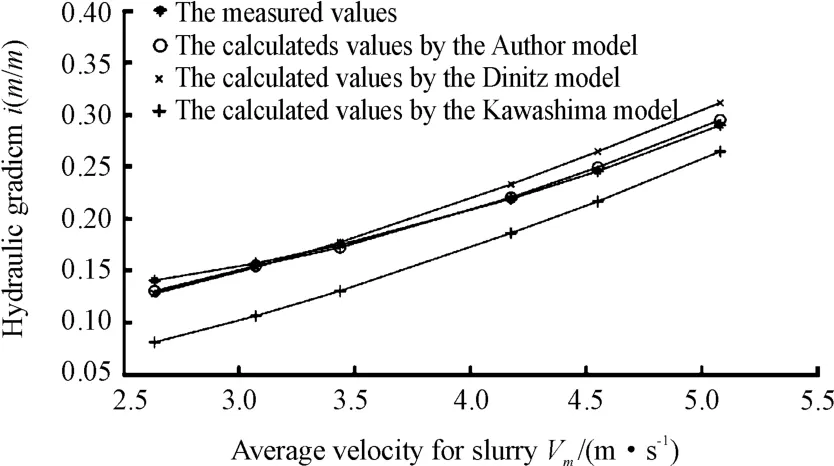
Fig.7 Comparison between author’s hydraulic gradient hydraulic gradient model and other models
5 Summary
Adopting literature research method and theoretical analysis method,it was analyzed and studied that the experimental data of large particle slurry pipeline transportation at home and abroad and the test data in production practice.The conclusions can be summarized as follows.
Based on the analysis of the forces exerted by the large-sized solid particles,the correction coefficient of interference force was put forward,and the influencing factors of this coefficient were analyzed.
The equation of particle motion in inclined pipeline is analyzed and studied,and the equation of continuity and the equation of momentum balance of liquid and solid are combined to solve the value of the correction coefficient K of the interference force under different flow test conditions.Then the equation of K is given by nonlinear fitting.
From the point of view of liquid-solid momentum exchange,adopted the equivalent resistance model and the non-linear fitting method,the hydraulic gradient(friction loss)was calculate for the large-particle slurry in pipeline considering the interference force factors.
Based on the measured data of many experts at home and abroad,the calculated value of the model is compared with the measured value.The calculation results show that the calculated value of hydraulic slope is close to the measured value after considering the correction factor K.The hydraulic gradient model for large particle proposed in the paper has certain theoretical reference value for the pipeline transportation technology of large particle slurry.
- 机床与液压的其它文章
- Analysis of cylindrical roller bearing with local damage based on multi-body dynamics
- Research on fault identification method of positive and negative fault subspace matrix
- Study on a LPs control algorithms in SCARrobot
- Research on mechanism of intelligent manufacturing equipment based on eye tracking control
- Path planning for obstacle avoidance of mobile robot based on optimized A*and DWA algorithm
- Real-time recommendation based on comprehensive popularity of items

